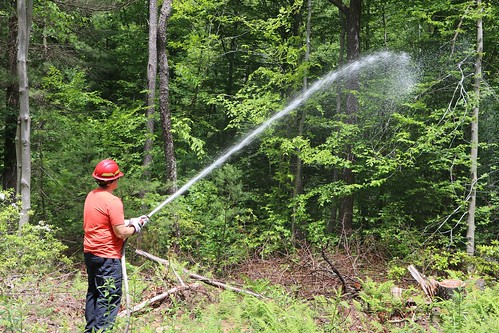Dry Hydrants
 The success of fire suppression operations depends on having a readily available watersource. In cities and developed suburban areas, fire hydrants are connected to public water systems and are readily accessible for firefighters. But many rural areas of the state do not have pressurized fire hydrant systems. In many cases, firefighters require water to be shuttled by tanker from the closest available source, usually from a town pressurized system, and it can be difficult for firefighters to maintain an uninterrupted water source at the scene.
The success of fire suppression operations depends on having a readily available watersource. In cities and developed suburban areas, fire hydrants are connected to public water systems and are readily accessible for firefighters. But many rural areas of the state do not have pressurized fire hydrant systems. In many cases, firefighters require water to be shuttled by tanker from the closest available source, usually from a town pressurized system, and it can be difficult for firefighters to maintain an uninterrupted water source at the scene.
The Maryland Department of Natural Resources and many local volunteer fire departments are responsible for battling wildland fires in some of the state’s most remote regions. For that reason, more than a decade ago the Maryland Forest Service used federal grant money for volunteer fire departments to install a solution–dry fire hydrants.
A dry fire hydrant is a non-pressurized pipe system permanently installed in a water source such as a lake, stream, or pond that permits the withdrawal of water by drafting from a fire truck to provide a reliable water source for fire suppression close to the incident.
DNR worked to install 114 new dry hydrants across the state, increasing the availability of rural water supplies. At the same time DNR took inventory statewide of known existing dry hydrants. The publication titled “Maryland Dry Hydrants” found on the DNR website provides a listing of 419 known dry hydrant sites on a county by county basis.
 The Maryland Forest Service, in cooperation with the U.S. Forest Service, provides up to $3,000 on a 50/50 match basis to enhance wildland fire suppression capabilities, including the installation of dry fire hydrants. The Volunteer Fire Assistance Grant program annually provides this type of funding to rural fire departments across the state.
The Maryland Forest Service, in cooperation with the U.S. Forest Service, provides up to $3,000 on a 50/50 match basis to enhance wildland fire suppression capabilities, including the installation of dry fire hydrants. The Volunteer Fire Assistance Grant program annually provides this type of funding to rural fire departments across the state.
With this continued cooperation among fire agencies, and leveraging of existing resources such as the dry hydrant system, DNR and part-ner agencies can help protect Maryland’s most remote regions from the spread of wildfires.
dnr.maryland.gov/forests
Article appears in Vol. 25, No. 3 of the Maryland Natural Resource magazine.
